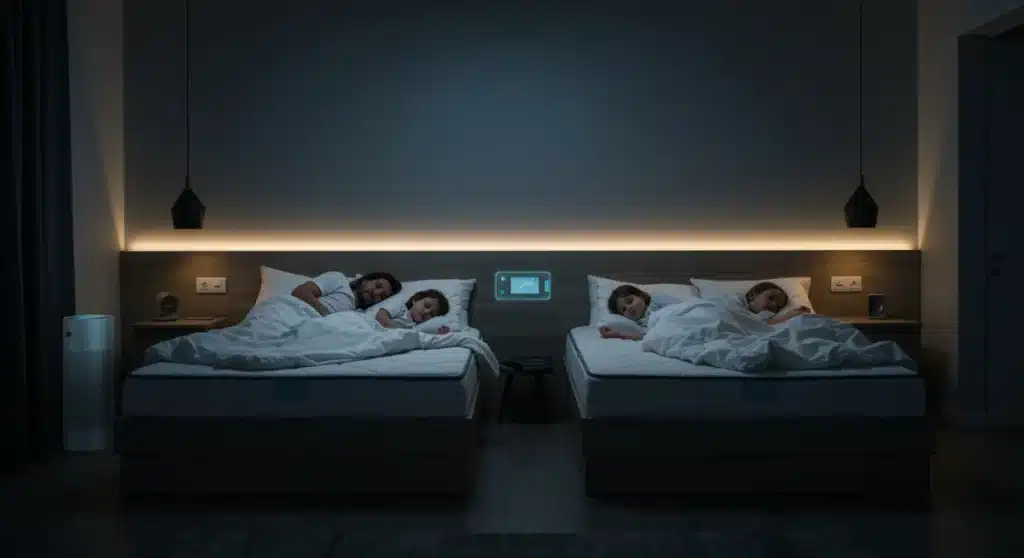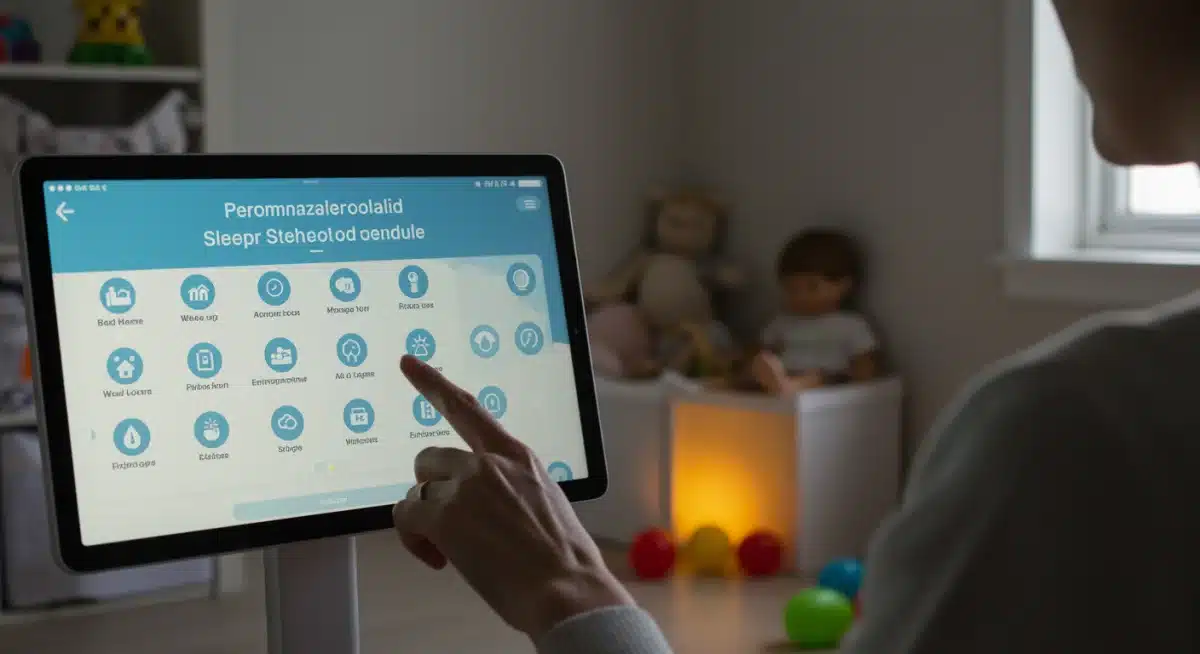Unlocking Better Sleep: 5 Strategies for Families in 2025

Unlocking Better Sleep: 5 Science-Backed Strategies for Families in 2025 (INSIDER KNOWLEDGE, PRACTICAL SOLUTIONS) is no longer a distant dream but an actionable reality for households navigating the complexities of modern life. As of early 2025, new insights and technological advancements are shaping how families approach rest, offering concrete steps to improve sleep quality for all ages.
Establishing Consistent Sleep Routines for All Ages
Establishing consistent sleep routines remains a cornerstone of effective sleep hygiene, a principle reinforced by recent pediatric and adult sleep studies published in late 2024. For families, this means harmonizing bedtimes and wake-up times, even on weekends, to regulate the body’s natural circadian rhythm. The benefits extend beyond individual rest, fostering a more predictable and calming home environment.
The latest research from the American Academy of Sleep Medicine (AASM) in January 2025 emphasizes that routine consistency is paramount, particularly for children and adolescents whose sleep patterns are still developing. Disruptions can lead to significant behavioral and academic challenges. Adults also benefit immensely, reporting reduced stress and improved cognitive function.
The Importance of Predictable Bedtime Rituals
Creating a predictable sequence of activities leading up to sleep signals to the body that it’s time to wind down. This can involve a variety of calming actions, tailored to individual family members.
- Warm Baths or Showers: A warm bath an hour before bed can aid relaxation and naturally lower body temperature, facilitating sleep onset.
- Reading Together: Sharing a book or engaging in quiet individual reading can replace screen time, reducing exposure to blue light.
- Gentle Stretching or Meditation: Simple stretching exercises or guided meditation apps designed for relaxation can calm both body and mind.
- Dimming Lights: Gradually reducing light exposure in the evening helps stimulate melatonin production, the body’s sleep hormone.
Adapting Routines for Different Age Groups
While consistency is key, routines must be age-appropriate. Infants and toddlers benefit from early bedtimes and naps, while school-aged children and teenagers often require later bedtimes but still need adequate sleep duration. Parents should monitor sleep cues and adjust schedules as children grow, always prioritizing sufficient rest.
Optimizing the Sleep Environment with Smart Technology
The sleep environment plays a critical role in sleep quality, and 2025 sees an increasing integration of smart home technology to achieve optimal conditions. From temperature control to light management, these innovations offer precise adjustments, creating a sanctuary conducive to deep rest for every family member.
Recent reports from tech wellness expos in early 2025 highlight advanced smart beds and integrated bedroom systems designed to monitor sleep patterns and automatically adjust environmental factors. These systems aim to minimize disruptions and maximize restorative sleep cycles, moving beyond basic automation to personalized sleep optimization.
Smart Lighting and Temperature Control
Intelligent lighting systems, often connected to circadian rhythm tracking, can gradually dim in the evening and brighten gently in the morning, mimicking natural light cycles. Smart thermostats can maintain an ideal sleep temperature, typically between 60-67 degrees Fahrenheit (15-19 degrees Celsius), throughout the night.
Soundscapes and Air Quality Management
- White Noise Machines: Advanced white noise or sound machines can mask disruptive noises and provide soothing background sounds, promoting continuous sleep.
- Air Purifiers: High-efficiency particulate air (HEPA) filters integrated into smart air purifiers can remove allergens and pollutants, improving air quality for easier breathing and reducing nighttime irritation.
- Aromatherapy Diffusers: Smart diffusers can release calming essential oils, such as lavender, on a schedule, further enhancing relaxation.
These integrated systems are becoming more affordable and user-friendly, making environmental optimization accessible to a wider range of families, according to consumer electronics reviews from February 2025.

Managing Digital Device Usage Before Bedtime
The pervasive presence of digital devices poses one of the most significant challenges to healthy sleep, particularly for children and teenagers. In 2025, medical professionals and sleep experts continue to issue strong recommendations regarding device usage, emphasizing the detrimental effects of blue light exposure and mental stimulation before bed.
A comprehensive review published in the Journal of Clinical Sleep Medicine in late 2024 reiterated that blue light emitted from screens suppresses melatonin production, delaying sleep onset and impacting sleep quality. Furthermore, engaging with social media, video games, or stimulating content can keep the brain active, making it difficult to transition to a restful state.
Implementing a Digital Curfew
Establishing a firm digital curfew for all family members is essential. This means no screens—phones, tablets, computers, or televisions—for at least one to two hours before bedtime. This allows the brain to wind down naturally and melatonin levels to rise.
- Designated Charging Station: Create a central charging station outside the bedrooms for all family devices to prevent late-night temptation.
- Alternative Evening Activities: Encourage non-screen activities such as reading physical books, board games, or family discussions.
- Parental Controls: Utilize parental control features on devices and routers to enforce screen time limits and restrict access during designated sleep hours.
Educating on Screen Time Impact
Openly discussing the science behind blue light and mental stimulation with children and teenagers can empower them to make healthier choices regarding their device usage. Understanding the ‘why’ can be a powerful motivator, as noted by educational psychologists in their 2025 reports on adolescent well-being.
Prioritizing Nutrition and Physical Activity
Diet and exercise are deeply intertwined with sleep quality, a connection increasingly highlighted in 2025 wellness guidelines. What families consume and how they move their bodies significantly impacts their ability to fall asleep, stay asleep, and achieve restorative rest. Balancing these elements is crucial for overall family health.
According to the latest nutritional science from the World Health Organization (WHO) and national health agencies in early 2025, diets rich in processed foods, excessive sugar, and caffeine can disrupt sleep patterns. Conversely, regular physical activity, when timed appropriately, promotes deeper and more consistent sleep, as indicated by new studies from sports medicine institutes.
Dietary Choices for Better Sleep
Focusing on a balanced diet throughout the day can prevent energy crashes and surges that disrupt sleep. Specific nutrients are also known to support sleep.
- Limiting Caffeine and Heavy Meals: Avoid caffeine in the late afternoon and evening, and heavy, fatty meals close to bedtime, which can cause indigestion.
- Incorporating Sleep-Friendly Foods: Foods rich in tryptophan (like turkey, nuts, seeds), magnesium (leafy greens, whole grains), and calcium (dairy products) can promote relaxation.
- Hydration: Staying well-hydrated throughout the day is important, but reduce fluid intake in the hour or two before bed to minimize nighttime bathroom trips.
The Role of Regular Exercise
Consistent physical activity is a powerful sleep aid. However, timing is everything. Engaging in moderate to vigorous exercise earlier in the day can improve sleep quality, while intense workouts too close to bedtime can be stimulating.
Children benefit from ample playtime outdoors, which helps regulate their circadian rhythms and expends energy. For adults, a brisk walk, run, or gym session in the morning or afternoon can significantly enhance nighttime rest, as confirmed by recent fitness and sleep synergy research presented at the Global Health Summit in January 2025.
Addressing Sleep Challenges and Seeking Professional Help
Despite implementing optimal strategies, some families may continue to face significant sleep challenges. Recognizing when to seek professional help is a vital component of Unlocking Better Sleep: 5 Science-Backed Strategies for Families in 2025. Persistent sleep issues in any family member warrant attention from healthcare providers.
The American Academy of Pediatrics (AAP) and other leading health organizations updated their guidelines in late 2024, emphasizing early intervention for sleep disorders. Untreated sleep problems can have long-term consequences on physical health, mental well-being, and overall family dynamics. Parents are urged to trust their instincts if a child’s sleep seems consistently problematic.
Common Sleep Disorders and Symptoms
While occasional restless nights are normal, certain symptoms may indicate an underlying sleep disorder. Awareness of these signs is crucial for timely diagnosis and treatment.
- Snoring and Pauses in Breathing: These can be signs of sleep apnea, a condition requiring medical evaluation.
- Difficulty Falling or Staying Asleep: Chronic insomnia, whether behavioral or physiological, impacts both children and adults.
- Excessive Daytime Sleepiness: Despite adequate sleep duration, persistent fatigue can point to issues like narcolepsy or insufficient sleep quality.
- Restless Legs Syndrome: An irresistible urge to move the legs, often accompanied by uncomfortable sensations, can severely disrupt sleep.
When to Consult a Specialist
If sleep problems persist for more than a few weeks, significantly impact daily functioning, or are accompanied by concerning symptoms, it’s time to consult with a pediatrician, family doctor, or a sleep specialist. These professionals can conduct evaluations, recommend sleep studies, and develop tailored treatment plans.
Many sleep centers now offer family-focused approaches, recognizing that one person’s sleep issues can affect the entire household. Telehealth options for initial consultations have also expanded significantly in 2025, making expert advice more accessible for busy families, according to healthcare technology review platforms.
Building Resilience Through Rest and Mindfulness
Beyond the physical aspects of sleep, the psychological and emotional components are gaining increased recognition in 2025. Cultivating mindfulness and emotional resilience within the family unit can significantly contribute to better sleep. Stress and anxiety are potent disruptors of sleep, and developing healthy coping mechanisms is essential for all ages.
Recent psychological studies published in early 2025 highlight the bidirectional relationship between stress and sleep: stress impairs sleep, and poor sleep exacerbates stress. For families, this creates a cycle that needs proactive management. Integrating mindfulness practices can break this cycle, fostering a calmer environment conducive to rest.
Mindfulness Practices for Family Well-being
Mindfulness doesn’t require extensive training; it can be integrated into daily life through simple exercises that promote present-moment awareness and reduce rumination before bed.
- Daily Gratitude Practice: Before bed, each family member can share one thing they are grateful for, shifting focus to positive thoughts.
- Mindful Breathing Exercises: Simple deep breathing techniques can calm the nervous system, making it easier to fall asleep. Apps and online resources offer age-appropriate guided meditations.
- Body Scan Meditation: Lying down and focusing attention on different parts of the body can help release tension and prepare for sleep.
Fostering Emotional Resilience
Teaching children and practicing as adults how to manage emotions and cope with stress is a long-term investment in sleep health. Open communication about feelings, providing reassurance, and validating emotional experiences can reduce bedtime anxieties.
Creating a safe space for family members to express their concerns without judgment can prevent worries from escalating, which often interfere with sleep. This proactive approach to emotional well-being is increasingly emphasized by child development experts in 2025, linking it directly to improved sleep outcomes and overall family harmony.
| Key Strategy | Brief Description |
|---|---|
| Consistent Routines | Establish regular bedtimes and wake-up times, even on weekends, to regulate circadian rhythms for all family members. |
| Optimized Environment | Utilize smart tech for lighting, temperature, and sound to create a dark, quiet, and cool bedroom conducive to sleep. |
| Digital Device Management | Implement a digital curfew (1-2 hours before bed) to minimize blue light exposure and mental stimulation from screens. |
| Nutrition & Activity | Balance diet by avoiding late caffeine/heavy meals and ensuring regular, appropriately timed physical activity. |
Frequently Asked Questions About Family Sleep
Screen time, especially before bed, exposes children to blue light which suppresses melatonin, the sleep-inducing hormone. This delays sleep onset and can disrupt the natural sleep cycle, leading to reduced sleep quality and duration. Engaging content also keeps their minds active, making relaxation difficult.
The ideal bedroom temperature for optimal sleep across most age groups is generally between 60 to 67 degrees Fahrenheit (15 to 19 degrees Celsius). A slightly cooler environment helps the body’s core temperature drop, which is a natural signal for sleep initiation and maintenance.
Yes, diet significantly influences sleep. Heavy, fatty meals close to bedtime can cause indigestion. Caffeine and high sugar intake, especially in the evening, act as stimulants. Conversely, foods rich in tryptophan, magnesium, and calcium can promote relaxation and aid in better sleep for all family members.
Families should seek professional help if sleep problems persist for several weeks, significantly impact daily functioning, or if symptoms like chronic snoring, breathing pauses, or excessive daytime sleepiness are present. A pediatrician or sleep specialist can diagnose and recommend tailored interventions.
Consistent sleep routines, including regular bedtimes and wake-up times, help regulate the body’s circadian rhythm. This predictability signals to the body when it’s time to sleep and wake, leading to easier sleep onset, more consolidated sleep, and improved overall sleep quality for every family member.
Looking Ahead: The Future of Family Sleep Wellness
As 2025 progresses, the emphasis on integrated wellness solutions for families is expected to grow, with sleep recognized as a foundational pillar. What this means is a continued evolution in smart home technologies, more personalized sleep tracking, and a greater societal understanding of the impact of sleep on mental and physical health. Families should anticipate further advancements in accessible sleep education and behavioral therapies. The current focus on proactive strategies and early intervention will likely become standard practice, empowering households to navigate sleep challenges with greater confidence and support. The ongoing research into chronobiology and its applications will further refine our approaches to achieving optimal rest for all ages, fostering healthier, more resilient family units.





